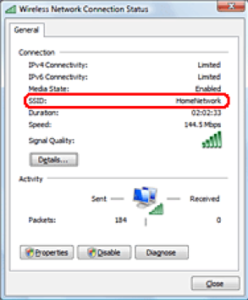SSID aka Service Set Identifier
Did you ever see the acronym ‘SSID’ when connecting to any Wi-Fi network and ask yourself what it meant? In this article, we have shared all that you need to know about SSID.
‘SSID’ is short for ‘Service Set Identifier’, it is the wireless network’s name and differs from the router’s name. Under IEEE 802.11 wireless networking standard, “Service set means a collection of wireless network devices within the same parameters”. SSID helps you to identify which network you can connect to.

When you see several Wi-Fi networks available for connection, what you see is the name of the router or the station. Whereas an SSID is a 32-character long name. They were designed so that you can differ between several other networks in your area and connect to the correct one. When multiple networks are operating from a single area, SSID makes delivery of the data easy by identifying the correct destination.
The SSID allows you to add some special characters like dashes, underscores, periods, and spaces. When you purchase a new router you see that there is a default SSID like ‘Netgear’ etc. If you have access to your Wi-Fi admin settings you can access it and change the SSID to anything that you like and can also add any of the special characters.
If the network is public you only need the SSID and can connect with it, but if it’s a private network it will be protected by WPA2 or any other type of password.
What should be considered before choosing an SSID?
Now that you know what an SSID is, you might face some difficulties while choosing your SSID name. When a device is connected to an SSID it remembers it and in the future automatically connects to it. There are instances where multiple networks end up keeping the same SSID. In this case, the device connects to the one with the strongest signal. We all use the terms like Wi-fi name or the network name in our daily life without even knowing that they are all synonyms of SSID.
Connecting to an SSID is an easy task once you have access to its passphrase. You can always set it from your router but there are several things that you should consider before opting for the correct SSID.
- When you are choosing a network’s name, try to keep it as simple and unique as possible. For eg If there are multiple networks with the name ‘Prints’, it can confuse you and other users as well. Try to keep your network name simple so that you can easily recognize it from the list and connect to it.
- Sometimes people do not change the SSID and keep it as the default, which is often the routers name like Netgear, there is a high chance that you might find many other networks around you with this name, so it is always advisable to customize the SSID and keep it as you prefer.
- Always check if your router has band steering. So that in times where there is dual-band it need not have dual SSID’s.
- Some Routers that do not have band steering, will have the option to allow you to name the 2.4GHz band with one name and the 5 GHz band with another so that you can connect to the one you want to be based on the speed and coverage.
- To know whether your device supports band steering or not you can check your device details from the invoice you get with your router or can check online.
- If you wish to configure to Guest networks, it is always advisable to do it on the same device as that of the main network so that you do not get confused.
- In the case where band steering is not available to your devices, try opting for dual SSIDs for the guests.
- Many people tend to hide their SSID’s to prevent them from getting spotted and misused. Its more of a privacy concern.
- WE recommend you to keep a strong passphrase but keep your SSID visible.
- Connecting to a hidden wi-fi network can be a tedious process and can get annoying for people who need to connect with it daily. It requires you to send a request first and then when it is authenticated, you can connect.
- Hiding of the SSID also brings a negative impact on its performance.
- When you are facing a PC, mobile, or any other device clinging to your Wi-Fi it is called the sticky client, and the best way to deal with it is by client steering. This gives access to multiple points in your network so that the devices can scan and connect to the one with the best range.
- So when you have devices that support client steering always opt for it.
Wrapping it up
SSID is the wireless networks name that is 32 characters long and can be seen and connected to for accessing the Wi-Fi. Make sure that you do not repeat the SSID as the ones around you as it can create confusion and disturbance.
Keep it unique and simple and always protect it with a passphrase that you can remember. All this can be easily set up by configuring the admin settings in your router.
We hope that this article has helped you clear any misconceptions you had about the SSID.
